Veneto boasts some of the most famous tourist resorts in Italy, but in addition to its countless art cities, such as Verona and Venice, and, of course, to the Lake Garda, it also fascinates with its picturesque villages and walled towns which have succeeded in preserving ancient traditions, local products and unique landscapes.
So if we've tickled your traveler's curiosity, here's a list of the 10 most beautiful villages in Veneto not to be missed during your tours in the region.

The most beautiful villages in Veneto
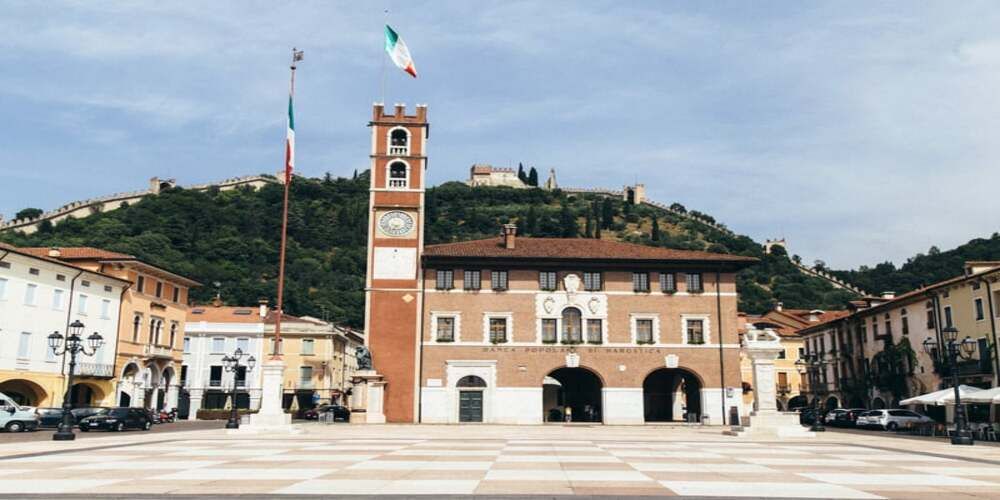
Veneto is among the most popular regions for tourists because of its numberless and unmissable beauties and its villages, albeit often small, are fascinating and history-rich must-see destinations.
Visiting the most beautiful villages in Veneto is a great idea for a special and different weekend, because it can be easily combined with cultural itineraries that have as main destinations the most famous art cities of the region, such as Verona, Venice and Padua.
From Lake Garda to the mountains, passing through the soft hills covered with vineyards, you can choose the village that inspires you the most, discover its history and traditions, admire splendid views and taste the typical products , actually not going too far from the big cities and then improvise a small detour at the very last moment, as well. An excellent opportunity are the traditional events, medieval festivals and fairs attracting tourists and daily visitors every year.
Are you ready to discover the 10 most beautiful villages in Veneto?
Discover lake Garda10. Malcesine
In the province of Verona, on the eastern shore of Lake Garda, lies Malcesine, a medieval village offering unforgettable sceneries.
Also called the “Pearl of the Lake”, it is one of the most popular villages in the area because of its fine monuments-the Scaliger Castle and the Palazzo dei Capitani. Also worth visiting is the picturesque historic center with its narrow streets, small stores, taverns, and relaxing lake views, surrounded by white pebble beaches.
In the background is Mount Baldo, which, with its 2,000 meters for the highest peaks, provides dreamlike landscapes to be walked.
9. Montagnana

In the province of Padua, Montagnana, also known as the walled city, is one of the best-preserved medieval towns in Italy.
Its imposing walls have never been modified, making it a unique village in Europe. The Rocca Degli Alberi, the Mastio and the Castello di San Zeno stand out within the imposing walls surrounded by a moat.
The old city center is appreciated for its cathedral, its Renaissance-era buildings and its alleys full of typical places where you can taste local products, first and foremost Prosciutto Veneto Euganeo Berico DOP. Don't miss the walk around the two-kilometer-long wall path.
8. Cittadella
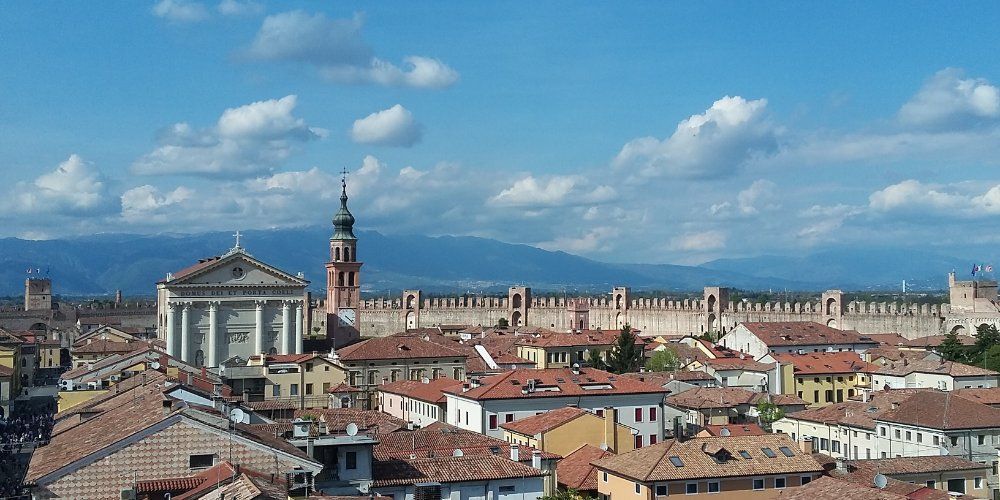
Among the 37 walled cities in the Veneto region, in the province of Padua, we find Cittadella, the only walled city in Europe, with an elliptical-shaped medieval patrol walk, which is totally walkable. Dating back to 1220, it is definitely one of the main tourist attractions of this fortified town and can be visited with a scenic promenade, 15 meters above the ground.
The surrounding landscape can be totally admired from above and as well as the details of the old center with its alleys and most important buildings, including the ancient social theater, the Cathedral with its frescoes, the Church of Santa Maria del Torresino with its wooden crucifix, and the Tower of Malta. Walking through the streets of the village, visitors are also faced with the three entrance gates: Porta Padovana, Porta Vicentina and Porta Trevisana.
Cittadella is certainly one of the most beautiful villages in Veneto, a work of urban art and a time machine that takes us back to the Middle Ages.
7. Marostica
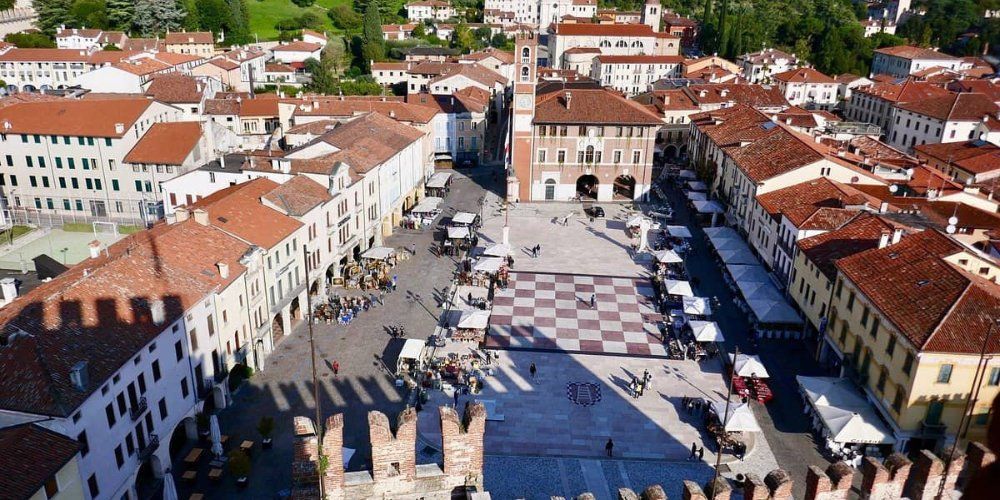
Marostica, in the province of Vicenza, is undoubtedly one of the most beautiful villages in Veneto and within its ancient walls it still holds the magic of the past.
Known as the “city of chess”, it is world-famous for its living chess game, which takes place every 2 years on the second weekend in September and involves more than five hundred figurants, dressed in medieval costumes, moving on a giant chessboard.
It is a historical re-enactment of the chess game played in 1454 in the central square of the village. According to legend, two noblemen who were in love with the beautiful Lionora, daughter of the castellan, challenged each other to a chess match to marry her.
But there is more to discover in this medieval village starting with the two castles, the upper and lower castles, connected by the characteristic town wall. The lower castle, dating back to the 14th century, boasts an external patrol path and offers a wide view of Chess Square, which is even more beautiful from above. Also not to be missed is the Carmini path, a scenic route following the walls, offering an impressive panorama.
In addition, strolling through the alleys of the center you will find small stores, taverns and many wine bars where you can taste wines and grappas from Veneto.
6. Burano
Burano, one of the three main islands in the Venice lagoon, is one of the most colorful places in the world! Even from a long distance, in fact, you can admire its colorful tiny houses, which are said to have been painted by sailors in order to make them easily recognizable on foggy days.
The tourist center of the island is Piazza Galuppi, where we find the main historic buildings such as the church of San Martino Vescovo, a curious building that has only a side entrance and a leaning bell tower similar to the Tower of Pisa. Also in Galuppi Square are the town hall building and the Lace Museum, where it is possible to learn about Burano's lace-making art.
But to experience the atmosphere of the island at its best, you need to get lost in its colorful alleys. Move away from the central square and as you stroll, you will come across Bepi Suà's house and Gianfranco Rosso's house, which, with their hand-painted pictures on the wall, are among the most beautiful and picturesque houses on the whole island.
Other distinctive places to take romantic and poetic photos are the Love Viewing Bridge and the Three Bridges, which connect three canals and three of main streets on the island. These are packed with small stores and restaurants where you can taste typical local dishes, first and foremost Risotto di Gò, a typical fish dish, and Bussolà, a crumbly-dough cookie.
Burano is one of the most beautiful villages in the Veneto because it represents an ancient, peaceful and, above all, unusually colorful world.
Treat yourself to a tour of the Venetian islands5. Asolo
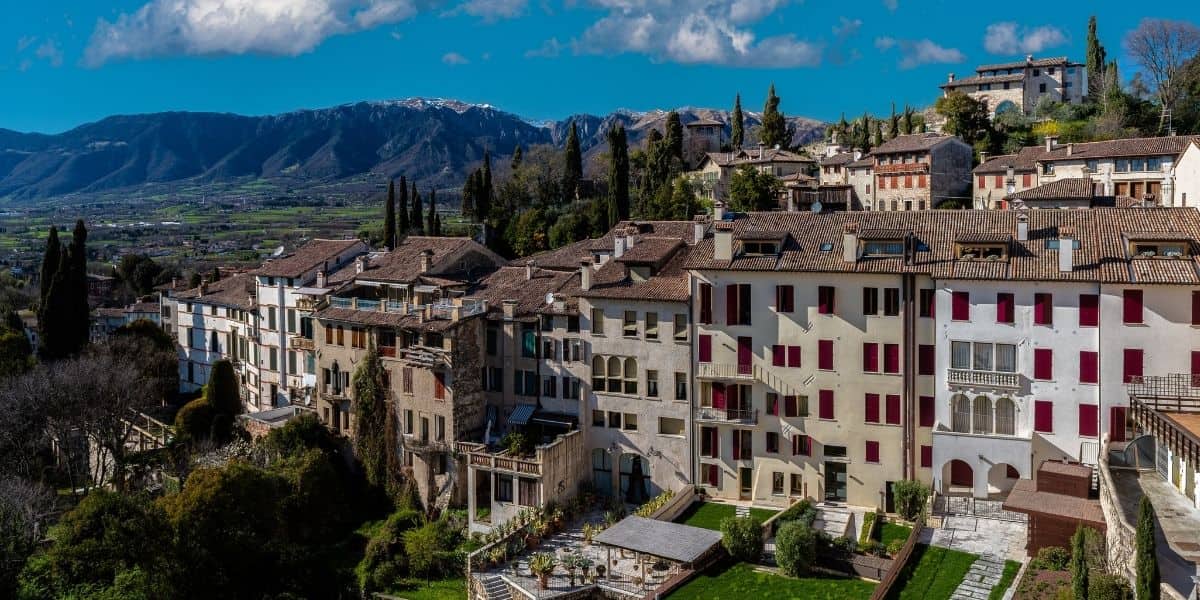
Asolo is a small village in the province of Treviso that belongs to the Club of the Borghi più Belli d'Italia (Italy's Most Beautiful Villages).
Because of its enchanting panoramic position among the hills, it was a destination for artists and writers from all over Europe; Giosuè Carducci called it “the city of a hundred horizons,” and Eleonora Duse, famous actress and lover of Gabriele D'Annunzio, spent the last years of her life here.
The village is also linked to the figure of Caterina Cornaro, who became queen of Cyprus and gave the island to the Republic of Venice, receiving Asolo in exchange, where she then lived from 1489 to 1509, transforming the castle into a gathering place for scholars and artists.
The symbol of the village is the Rocca, which dominates the landscape from the peak of Monte Ricco, offering a wonderful view. From here you can glimpse the historic center with its most important monuments: Piazza Garibaldi with its 16th-century fountain, the Castle, now home to the Duse Theater, the ancient Cathedral, and then again the Museo Civico, inside the 15th-century Palazzo della Ragione, and the 16th-century Villa degli Armeni.
You cannot leave Asolo without tasting its typical products, such as the excellent Prosecco wine, extra virgin olive oil made from the special Asolo olive and Asolo flowers, delicious rose-shaped cakes made with puff pastry and apple slices.
4. Soave
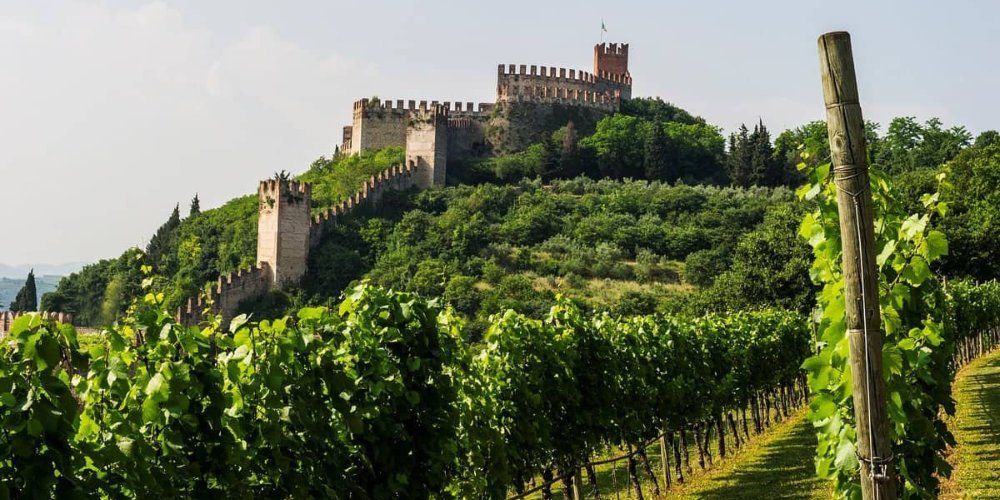
Famous for its Scaliger-era Castle, its city walls and its wine of the same name, the medieval village of Soave, the province of Verona, welcomes us surrounded by vineyards.
The history of the village is linked to that of its Roman-era castle: restored in the 14th century, Soave Castle is an example of a medieval fortress with drawbridges, crenellated walls and the imposing keep. The walls surrounding the village were built at the behest of the Scaligeri family to defend the territory, and it is possible to walk around the walls to observe the entrance gates with their dual access system.
Another beautiful walk for those who do not suffer from vertigo is the one on the patrol walkways, from which there is a wonderful view of the vineyard-covered valleys and the rooftops of the medieval old town. Around Piazza Antenna, which is the heart of it, we find the main monuments of Soave: the Cathedral of San Lorenzo, the Palace of Justice, and the Palazzo del Capitano, the seat of the Municipality.
In the city that bears the name of its famous wine, you cannot miss a few glasses in one of the many wine cellars in the historic center, but also the route called, Strada del Vino Soave, which has about 50 kilometers among wineries, vineyards, parish churches, castles, divided into 13 municipalities.
3. Castelfranco Veneto
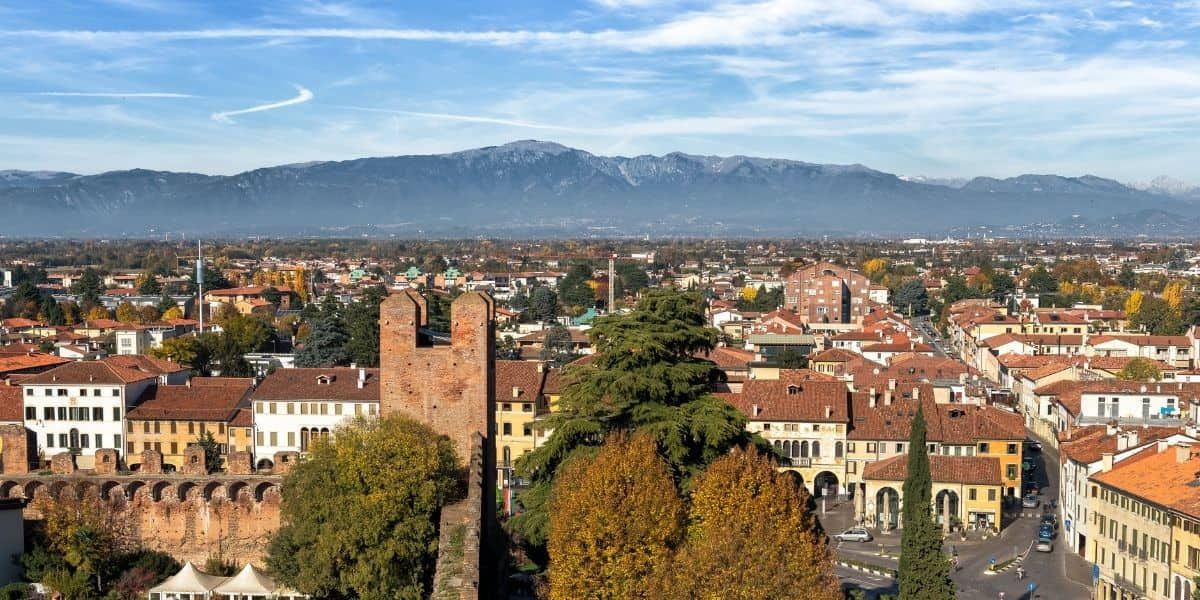
In the province of Treviso and also close to Padua and Vicenza, we find Castelfranco Veneto, a medieval walled city guardian of excellence from various eras. The symbol of the town and its history are the castle and its walls, erected in the late 22nd century.
During the rule of the Serenissima, Castelfranco became a cultural hub and home to intellectuals. Here one of the greatest painters of the Renaissance was born and trained: Giorgio Zorzi, better known as “il Giorgione”.
A visit to the city can only begin with the Castle, its towers and walls. Not to be missed is the Cathedral, which houses the Castelfranco altarpiece, a painting made precisely by Giorgione in 1502. The other places of interest in the historic center are the artist's House Museum, the Academic Theater, the church of San Giacomo, and a few kilometers from the center, Villa Revelin Bonasco with its park. In the area there are also as many as 16 Venetian villas protected by the Regional Institute for Venetian Villas.
Castelfranco is also a popular destination for hikers as its territory offers trails and paths in nature, such as the Regional Natural Park of the Sile River and cycle-tourist routes such as the Strada del Radicchio Rosso di Treviso and the Strada del Vino del Montello (Treviso Red Radish Road and the Montello Wine Road).
2. Feltre
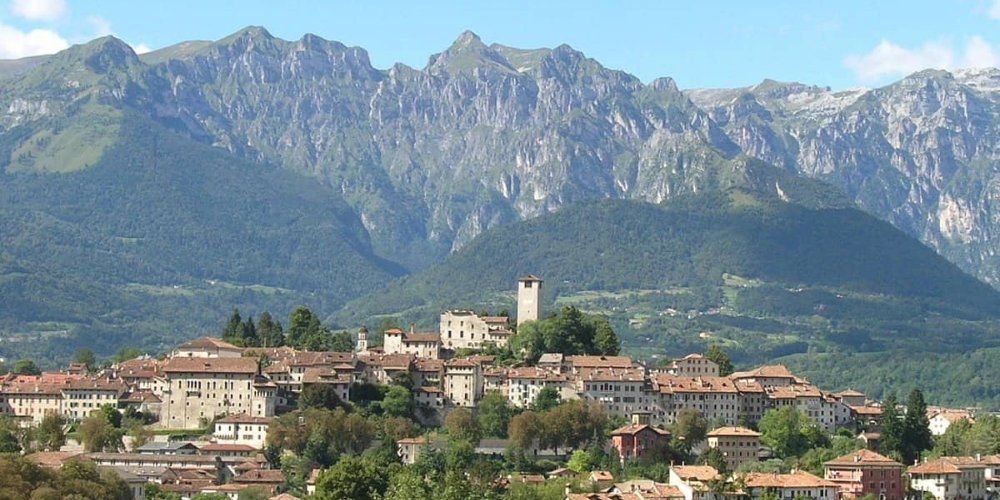
Situated to the west side of the Piave River, Feltre lies on the slopes of Colle delle Capre, surrounded by its imposing Renaissance walls. Rich in history, it is set in a natural environment of the highest value: the Feltre Alps, gateway to the Belluno Dolomites National Park, a World Heritage Site.
This city has always been a key transit route for trade and armies, linking the Roman and Germanic worlds for centuries - from the Po Valley, across the Alps and the Danube, to Bavaria.
Underground, we find a very large archaeological area that takes us back to Roman-age Feltre, while in the historic center, a succession of 16th-century palaces with frescoed facades, mullioned windows with two lights, and Renaissance-style balconies testify to the golden age that the city experienced under the rule of Venice. Among the most important buildings are the tower of Alboino's Castle, the Piazza Maggiore, the Palazzo della Ragione, which houses the old Teatro de la Sena, and the 16th-century Palazzo Cumano, home to the “Carlo Rizzarda” Gallery of Modern Art.
Around Feltre, tourism is synonymous with unspoiled nature, trails and outdoor life. In this sense, not to be missed is the valley of Mount Miesna, where the Sanctuary of Saints Vittore and Corona is also located, and the Lamen Valley, and from where the Belluno Dolomites can be reached.
1. Chioggia
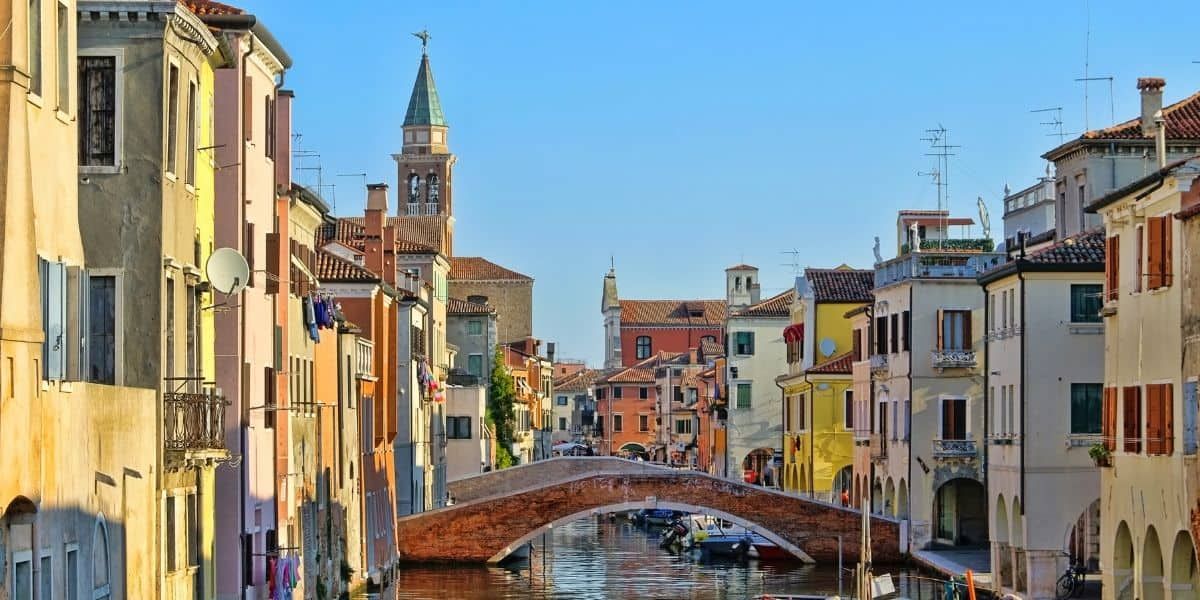
Located at the southernmost end of the Venetian lagoon, Chioggia encompasses a vast territory crossed by 3 major rivers: the Adige, Brenta, and Bacchiglione. These flow into the Adriatic Sea and give rise to a unique ecosystem of islands and beaches connected by bridges.
Chioggia is definitely a special place not only because of its urban layout but also because of the elegant palaces that overlook the canals, the colorful houses and boats, and the calle with evocative atmospheres. Walking through the village, you can feel the “Venetian atmosphere” but free from the tourist crowds: this feature has preserved the authenticity and charm of what was once the old fishing village.
Its charming historic center, of medieval origin, boasts the Cathedral of Santa Maria and not far away the Tower of St. Andrew with its ancient clock, still in operation today.
Continuing the walk, you come to one of the city's best-known places: the fish market, which is very busy during the day. Also not to be missed are Palazzo Granaio, Ponte Vigo, the equivalent of Venice's Rialto Bridge, the Church of San Domenico with its fine paintings, and the walk under the arcades that line Canal Vena.
Crossing the long Ponte di San Giacomo bridge you arrive at Sottomarina, Chioggia's beach, equipped with every comfort for relaxing days by the sea, and a strategic point for reaching Venice and the surrounding islands by sea.Here you can try street food and typical seafood cuisine.
Explore Venice from a privileged sight
The 10 most beautiful villages in Veneto: not only Venice
As you may have noticed, on this tour of the 10 most beautiful villages in Veneto you can breathe in the authentic and varied soul of this region, starting with its colorful landscape. From the sea to the mountains, passing through the lush green landscapes of the Po Valley, Veneto offers wonders for nature lovers, water and winter sports, as well as many unspoiled natural settings for trekking.
It also does not disappoint history buffs, who prefer to explore the alleys and palaces of historic centers, perhaps enjoying some local delicacies. In short, whichever type of traveler you belong to, if you're willing to leave aside for once the now-known splendor of the Venetian lagoon, don't underestimate a weekend getaway to one of these beautiful places and let your desire to explore guide you.
About the author
Written on 28/08/2021



Ilaria Capatti
Come with us to discover the 10 most beautiful villages in Veneto and their historical and natural wonders